The Best OLED Gaming Monitors to Buy in 2026
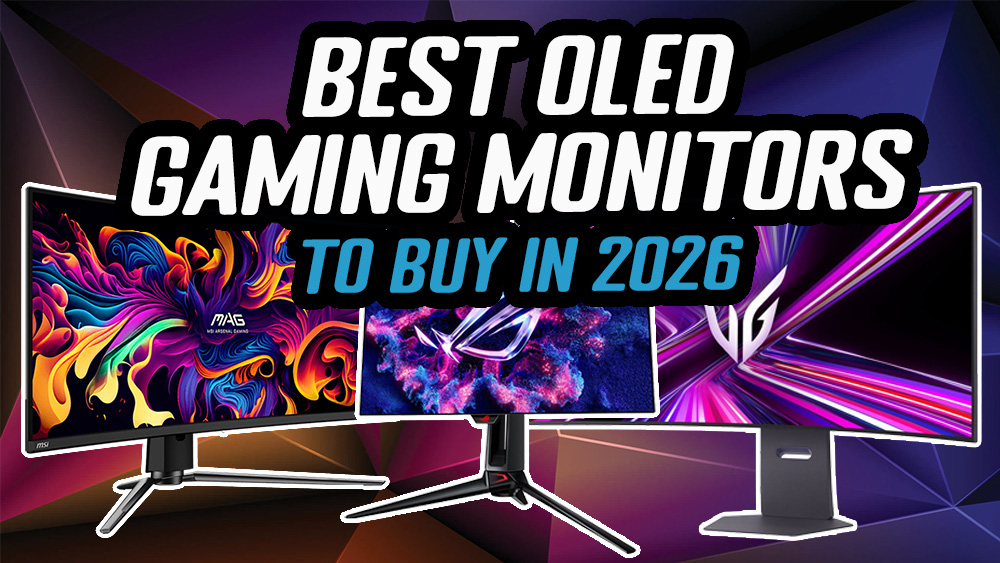
Introduction
If you’re in the market for a new monitor and have your eye on the growing range of OLED technology displays available, this guide will hopefully help you find the best OLED gaming monitors to buy in 2026 to suit your needs. We’ll run through at top level our top picks in each size category currently available, and provide a summary of each model along with any useful links where you can get further information, including our detailed reviews.
OLED Panels Pros and Cons
Mainstream OLED displays in traditional and sensible monitor sizes first appeared on the market in 2022, and there’s now a decent choice of size, manufacturer and price range available. This panel technology is mainly aimed at dynamic content uses like gaming, video and multimedia. They’ve got excellent, near-instant response times, offer high refresh rates with excellent motion clarity in gaming, and are also very well positioned to handle HDR games and video. The panels offer per-pixel level dimming so you avoid any issues with blooming or halos during HDR usage, as well as being able to individually turn pixels off to deliver true blacks and a basically infinite contrast ratio.
On the other hand they are less well suited to static content, with some challenges in text rendering caused by the somewhat unusual pixel layouts of the panels. The main challenge here though is around the risk of image retention and burn-in, so make sure you consider your usage carefully, although modern OLED care features and common 3-year warranties which cover burn-in should give you more peace of mind nowadays.
One key thing to keep in mind here that we will talk about in the recommendations is that there are two competing panel technologies being used here. WOLED from LG.Display and QD-OLED from Samsung Display. Each has it’s own slightly different performance characteristics and pros and cons, so you might need to consider your individual preference and uses before deciding which is right for you.
Our Recommendations for the Best OLED Gaming Monitors
Having reviewed and used many of the OLED display options on the market, as well as carefully considering reviews and opinions from other well-established reviewers, we’ve picked out what we consider to be the best OLED gaming monitors you can buy right now in a range of different sizes. These are arranged in order of size below from smallest to largest.
Quick access:
- 27″ 1440p top-tier
- 27″ 1440p mid-tier
- 27″ 4K
- 32″
- 34″ ultrawide
- 39″ ultrawide
- 45″ ultrawide
- 49″ super ultrawide
- Large format
Disclaimer: We may earn a commission if you purchase from our affiliate links in this review – TFTCentral is a participant in the Amazon Services LLC Associates Programme, an affiliate advertising programme designed to provide a means for sites to earn advertising fees by advertising and linking to Amazon.com, Amazon.co.uk, Amazon.de, Amazon.ca and other Amazon stores worldwide. We also participate in a similar scheme for Overclockers.co.uk, Newegg, Bestbuy and some manufacturers.
First up is the most popular size and form factor currently available, a 27” 16:9 aspect ratio display with a 2560 x 1440 resolution. We’ll provide recommendations here for both top-tier gaming models (i.e. higher priced) and then after this section, we’ll recommend some mid-tier options with a lower refresh rate and a lower price, in case you want something more affordable and don’t necessarily want or need the highest refresh rates available in this size.
27″ 1440p top-tier – Asus ROG Swift PG27AQWP-W

Our top pick in this segment is the Asus ROG Swift PG27AQWP-W which features a 2560 x 1440 resolution and a super-high 540Hz refresh rate. It has amazing gaming performance, and Asus have also added useful features like ELMB (Extreme Low Motion Blur) / BFI, and a dual-mode function that allows you to push refresh rate even higher to 720Hz, but only at a much lower 720p resolution.
Key Specs
| Spec | This screen |
| Size: | 27″ |
| Aspect Ratio: | 16:9 |
| Format: | Flat |
| Technology: | 4th Gen WOLED |
| Coating: | Glossy ‘TrueBlack’ |
| Resolution: | 2560 x 1440 |
| Refresh Rate: | 540Hz @ 1440p (plus dual mode 720Hz @ 720p) |
Things we like
This screen is built around the latest 4th Gen WOLED panel technology which offers improved brightness, black depth and colours compared with earlier WOLED panels. The panel also includes an updated sub-pixel structure that helps improve the text clarity compared with most older WOLED panels in this size, which makes it a more versatile monitor for all-round use.
This model also includes a ‘TrueBlack’ glossy screen coating for a super clear and sharp image. The screen has a new and unique design which we really like as well. Added extras like ELMB (aka BFI) that can be run up to 270Hz help to improve the motion clarity significantly if you have a lower-powered system, and are only made possible thanks to the high native refresh rate of the panel.
Things to keep in mind
This screen is gamer-focused obviously, but is missed some modern features you might find on other models like USB type-C connectivity, a KVM switch function, built in speakers and PiP/PbP support. If you are after any of those in particular, we’d recommend considering the MSI MAG 272QP X50 (buy it here) as an alternative option with a QD-OLED panel. Or if you don’t need the super-high refresh rates and want to save some money, our mid-tier recommendations in this size below may be of interest.
While there’s an impressive 720Hz mode available on this screen, it’s only available at a much lower 1280 x 720 resolution which makes it suitable only for very niche gaming situations we think.
Availability
Keep in mind that this is a very new screen and is only available in some regions so far, in many cases only for pre-order. It should be more widely available during early Q1 2026 though. If you don’t want to wait, we’ve got some other recommendations just below.
Summary
The PG27AQWP-W provides some extremely impressive performance and is currently the best overall gaming OLED monitor available we think. It won’t necessarily be for everyone, as others may prefer ultrawide formats or larger screen sizes, but we will provide recommendations for those below. If you’re after a 27″ 1440p OLED gaming monitor, this would be our recommendation. You can read our full written review here, or watch our video review here for lots more information too.
Where to Buy
Pros
- 540Hz refresh rate provides excellent gaming performance
- New pixel structure improves text clarity
- TrueBlack glossy coating and 4th Gen WOLED panel provide amazing picture quality
Cons
- Missing some modern features like USB-C, KVM, speakers, PiP/PbP
- BFI activation and operation is a bit cumbersome
- Dual-mode only available at very low resolution
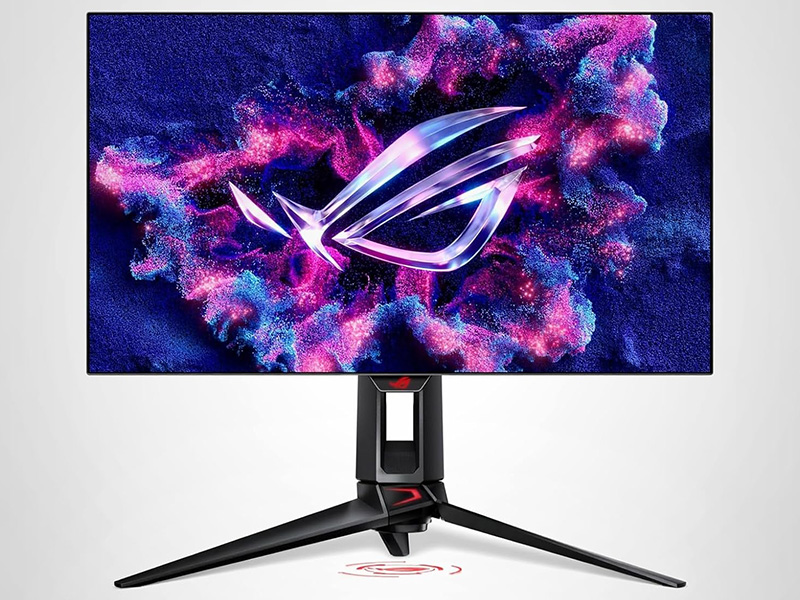
Alternative option – Asus ROG Swift PG27AQDP
This is another option, and our previous top recommendation. Worth looking at if you either can’t get the above recommendation yet (varies by region), or in case you can find this at a good discount during the sales. It has a 480Hz refresh rate WOLED panel, updated sub-pixel structure and BFI at 240Hz. A great gaming screen
[Buy here]
[Review here]
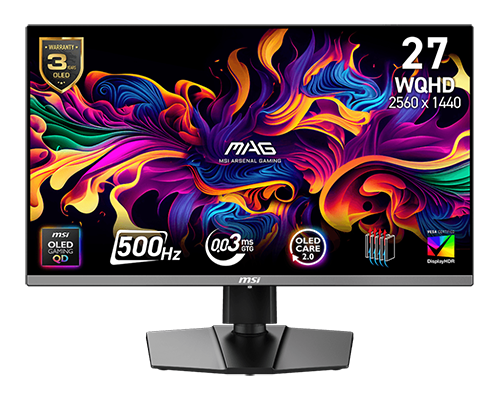
Alternative option
MSI MAG 272QP X50
Another option if you want some additional features, or specifically want a QD-OLED panel instead of a WOLED panel. These two models have the same 27″ QD-OLED panel with 1440p resolution and 500Hz refresh rate. It has a semi-glossy screen coating, and some additional extras like USB type-C and a KVM switch function. MSI have also now added features like BFI for blur reduction on these models.
[Buy here]
[Review here]
27″ 1440p mid-tier – Gigabyte MO27Q28G
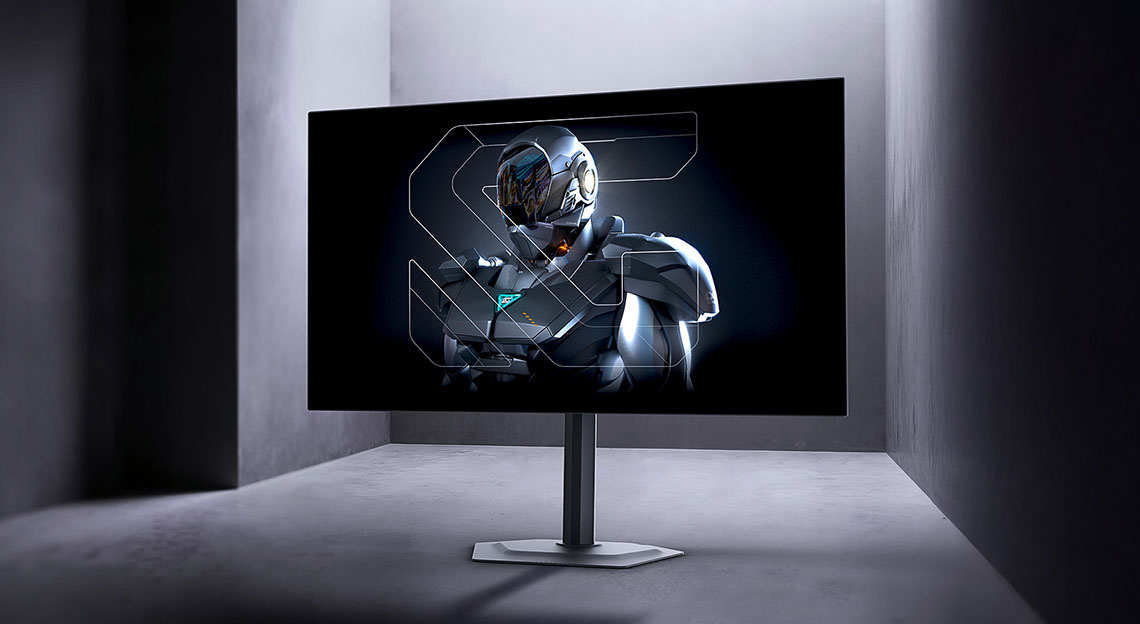
We’ve added an additional recommendation here for those who want a gaming OLED monitor but perhaps don’t want or need the super-high refresh rates available from our “top-tier” recommendations above. Not everyone wants 480 – 500Hz and there are some excellent options available at a lower cost, with lower refresh rates.
Our pick of the bunch here would be the Gigabyte MO27Q28G, built around a brand new 4th Gen “Primary RGB Tandem” WOLED panel. It offers a 1440p resolution and 280Hz refresh rate, but offers improvements in HDR and SDR brightness, black depth and colours compared with earlier-gen WOLED panels. It features the updated sub-pixel layout too which makes text clarity better.
Key Specs
| Spec | This screen |
| Size: | 27″ |
| Aspect Ratio: | 16:9 |
| Format: | Flat |
| Technology: | WOLED 4th Gen |
| Resolution: | 2560 x 1440 |
| Refresh Rate: | 280Hz |
Things we like
While 280Hz is not as fast as the top-end models, it still offers very good motion clarity and gaming performance. Gigabyte have added new BFI (blur reduction) and anti-flicker modes to this new model as well. The 4th Gen WOLED panel provides a load of benefits as we’ve already mentioned, and Gigabyte have included a wide range of features and extras too including USB type-C, a KVM switch and integrated speakers which make it a bit more versatile than our other suggestion in this category covered below.
Things to keep in mind
It won’t offer the raw speed of the 480 – 500Hz models so pro and esport gamers may prefer one of the faster models still. It’s only just being released and so availability in some regions will be limited for a while, but now it’s officially available and launched, we have included it in our recommendations list here.
Summary
The MO27Q28G is an excellent mid-tier refresh rate OLED gaming monitor. The 4th Gen WOLED panel provides a load of benefits with performance and there’s an excellent range of features and extras on offer here too. You can watch our full video review here for lots more information too.
Where to Buy
Pros
- 4th Gen WOLED panel provides loads of benefits with brightness, black depth and colours
- Updated pixel structure improves text clarity
- Newly added features like BFI and anti-flicker modes
Cons
- Lower refresh rate than other top-tier gaming OLED monitors
- BFI activation and operation is a bit cumbersome
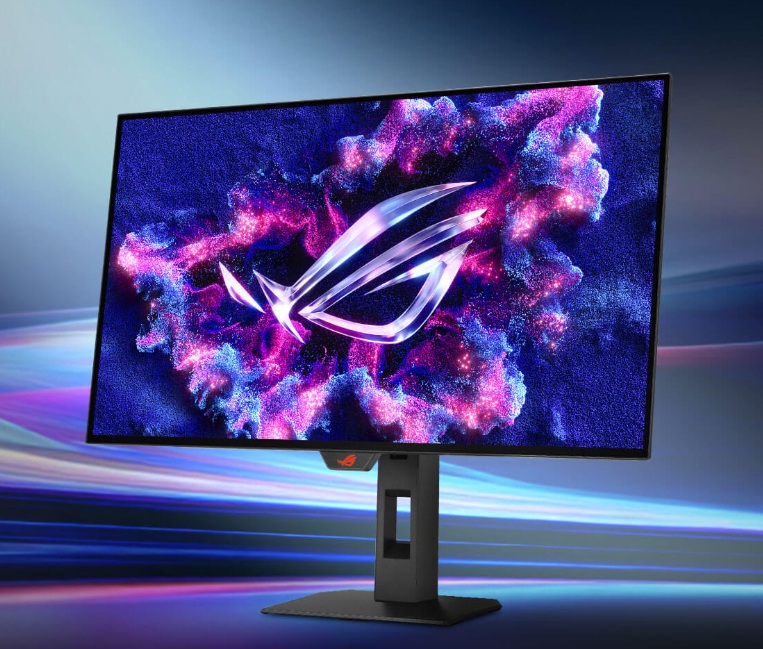
Alternative option – Asus ROG Strix XG27AQWMG
Another option with the same panel as the Gigabyte model (4th Gen WOLED) but with Asus’ added TrueBlack glossy coating for an impressive image. It lacks a few of the extras that the Gigabyte model has, but is a great choice and alternative, especially if you want a glossy screen. It’s availability will vary by region but it started to be released during Nov/Dec 2025.
[Buy here]
[Review here]
27″ 4K – Asus ROG Swift PG27UCDM

The new range of higher resolution 27″ OLED monitors has only started to appear in early 2025. We’ve reviewed the Asus ROG Swift PG27UCDM which is an excellent screen, and one we can certainly recommend. It has a 3840 x 2160 “4K” resolution which means a much higher pixel density (~166 PPI) than older 27″ OLED monitors. This leads to better text rendering and sharpness, and improved image detail in all situations. It can also natively support 4K devices like modern games consoles, and those who want to play highly detailed, graphically impressive game titles.
It has a 240Hz refresh rate and includes Asus’s Extreme Low Motion Blur (ELMB) feature for gaming, along with modern features like Dolby Vision HDR support and a full-speed DisplayPort 2.1 connection.
Key Specs
| Spec | This screen |
| Size: | 27″ |
| Aspect Ratio: | 16:9 |
| Format: | Flat |
| Technology: | QD-OLED |
| Resolution: | 3840 x 2160 “4K” |
| Refresh Rate: | 240Hz |
Things we like
The higher pixel density offered here really helps to eliminate any lingering concerns with text clarity for the vast majority of users, providing a really sharp and clear image. Having the latest DisplayPort 2.1 connection means you can run the screen with an uncompressed video signal as well, and it’s really good to see Asus’ usual range of extras like ELMB, Dolby Vision, anti-flicker settings and wide range of updated OLED Care features.
Things to keep in mind
Usual challenges apply for a QD-OLED technology panel when using it in a brightly lit room. You need to be mindful of your ambient lighting levels and position of light sources. We found the Dolby Vision HDR modes to be fairly dark too. Make sure you’ve got a powerful system if you want to try and game at 4K 240Hz, and you’ll need a modern graphics card with DP 2.1 UHBR20 support if you want to fully make use of that modern connection, although the screen of course still works fine on older DP 1.4 graphics cards too.
Summary
The PG27UCDM provides some extremely impressive performance, with a great feature set too, if you’re after a higher resolution OLED monitor. You can read our full written review here for lots more information too.
Where to Buy
Pros
- High resolution and pixel density provides very sharp and clear imag
- DisplayPort 2.1 offers future proof connectivity
- New features like OLED Care Pro, Neo Proximity Sensor and updated Anti-flicker modes were great to see
Cons
- HDR brightness and EOTF accuracy for brighter modes could be improved, along with Dolby Vision brightness
- QD-OLED panel can suffer from raised blacks depending on ambient lighting levels and positions
- ELMB operation is still clunky and not very bright

Alternative option – MSI MPG 272URX
Another very good option is MSI’s equivalent MPG 272URX built around the same 4K 240Hz QD-OLED panel. It doesn’t have BFI and the HDR brightness isn’t as high as the Asus model, but it still has an excellent spec and feature set including DisplayPort 2.1 connectivity.
[Buy here]
[Review here]
32″ – Asus ROG Strix XG32UCWMG

Having reviewed and tested loads of the 32″ 4K OLED monitors released over the last couple of years, our current overall favourite is the Asus ROG Strix XG32UCWMG. It’s built around an LG.Display WOLED technology panel and it’s got a 3840 x 2160 “4K” resolution and 240Hz refresh rate. This model features a new ‘TrueBlack’ glossy screen coating which offers exceptional image clarity, sharpness and contrast.
A “dual-mode” function, allowing you to drop your resolution to 1080p but double your refresh rate to 480Hz for certain gaming situations, allowing you to choose then between image detail and resolution, or frame rates and speed. We think this is a nice feature.
Key Specs
| Spec | This screen |
| Size: | 31.5″ |
| Aspect Ratio: | 16:9 |
| Format: | Flat |
| Technology: | WOLED |
| Resolution: | 3840 x 2160 “4K” |
| Refresh Rate: | 240Hz (with 480Hz dual-mode) |
Things we like
The 240Hz refresh rate delivers excellent motion clarity and gaming experience, with the high pixel density and updated pixel structure providing a sharp, detailed and crisp image. Asus have added quite a few extras as well including a USB type-C connection, KVM support, PiP/PbP modes and loads of gaming settings. This includes a Black Frame Insertion (BFI) function up to 120Hz for improving motion clarity in games and VRR anti-flicker modes too. They’ve also added their new Neo Proximity Sensor for OLED care.
Things to keep in mind
There are a couple of competing 32″ models which use this same panel and offer a slightly different feature set. Asus’ model is missing any integrated speakers and does not support hardware calibration unfortunately which you can find elsewhere. If you’re after a QD-OLED technology panel instead, there are plenty of great choices in this segment and we’ve suggested an alternative option below.
Summary
The Asus ROG Strix XG32UCWMG provides an excellent spec and range of features, backed by some impressive performance. You can read our full review of the XG32UCWMG here for lots more information.
Where to Buy
Pros
- Dual-mode provides excellent motion clarity and very high frame rate support for competitive gaming
- Nice range of extra features like USB-C, KVM, PiP/PbP, BFI
- Text clarity issue basically eliminated thanks to new pixel layout and increased pixel density
Cons
- ELMB (BFI) mode remains inflexible in options and operation, but is still nice to see included
- Glossy coating looks great, but may cause challenges with reflections in well-lit rooms. Consider the PG32UCDP instead if you’re concerned (below)
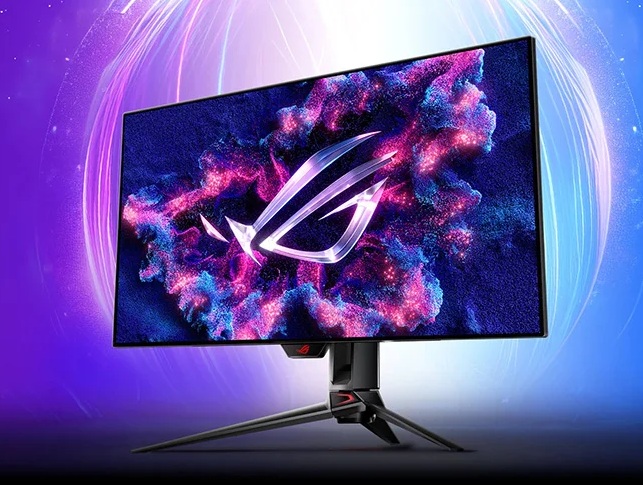
Alternative option – Asus ROG Swift PG32UCDP
An alternative option to the XG32UCWMG model using the same 32″ 4K 240Hz WOLED panel, but with a standard matte anti-glare screen coating instead. This is better for brighter lit rooms or those concerned with glare and reflections. Note that this version does not include the Neo Proximity Sensor though.
[Buy here]
[Review here]

Alternative option – MSI MPG 322URX / MPG321URX
Another option if you want to save a bit of money would be these two very similar monitors from MSI. They have a 32″ QD-OLED panel with 4K resolution and 240Hz refresh rate, and a decent range of additional extras like USB type-C and a KVM switch function. The MPG 322URX model includes DisplayPort 2.1 connectivity as well, or there’s the MPG 321URX which is the same but with DP 1.4. Both are very solid alternatives at a lower price point worth considering.
[Buy the MPG 322URX here] | [Buy the MPG 321URX here]
[Review here]
34″ Ultrawide – MSI MPG 341CQPX

If you want something a bit bigger, then there’s loads of different choices in the 34” ultrawide market. Our new pick in this size is the MSI MPG 341CQPX. It uses a newer generation Samsung QD-OLED technology panel which offers a 240Hz refresh rate, instead of the 175Hz that has been available in this segment for a few years now. This offers improvements in gaming performance and sets it apart from previous models. MSI have also included the impressive feature set in line with their other modern monitors.
Key Specs
| Spec | This screen |
| Size: | 34″ ultrawide |
| Aspect Ratio: | 21:9 |
| Format: | 1800R curvature |
| Technology: | QD-OLED |
| Resolution: | 3440 x 1440 |
| Refresh Rate: | 240Hz |
Things we like
The ultrawide format provides more desktop space for general and office uses than the 27″ models, and is also a popular choice for a lot of modern games that support ultrawide aspect ratios. There’s a load of added modern features like a USB type-C connection, KVM switch, PiP/PbP modes, a fan-less design and a great selection of OLED Care features. This sets it apart from many other 34″ ultrawide monitors on the market. We prefer this QD-OLED panel to the alternative, competing WOLED panel which might have the same 240Hz, but has an aggressive 800R curvature which we feel is too much in many situations.
Things to keep in mind
Being a QD-OLED panel, the sub-pixel layout and panel coating are different to the WOLED monitors on the market. Despite being a newer generation panel (we like to call this gen 2.5) than the first gen 175Hz panel from 2022, this screen still has the same pixel structure unfortunately and the text clarity is not as good as the other size QD-OLED panels. Unfortunately Samsung Display didn’t update the pixel structure even though it’s a newer, higher refresh rate panel produced this year.
The semi glossy screen coating provides a nice clean and clear image, looking better than the quite grainy WOLED matte coating. It handles reflections fairly well, better than a fully glossy coating at least, but doesn’t diffuse light sources as well so may not be as well suited to brightly lit rooms or locations where you have windows or lights facing the panel. The other drawback of QD-OLED panels is that in brighter rooms, the lack of a polarizer on the panel and the use of a Quantum Dot layer can cause blacks to look more greyish, reducing perceived contrast ratio. This is less apparent on WOLED panels.
Summary
The MPG 341CQPX is an excellent choice if you want a larger ultrawide format screen. You can watch our full detailed review for lots more information too.
Where to Buy
Pros
- Large screen size and ultrawide format
- New 240Hz refresh rate QD-OLED panel, better for gaming than older 175Hz models widely available
- Modern feature set and extras
Cons
- QD-OLED panel causes reduced contrast in brighter room conditions
- Sub-pixel structure was not updated even with the new panel leading to some lingering text clarity issues

Alternative option – Dell Alienware AW3425DW
Another option using the same QD-OLED panel and offering a 240Hz refresh rate. Dell are a popular mainstream brand and make some very solid screens. It is available at a decent price point as well, so maybe worth a look alongside the MSI model.
[Buy here]
39″ Ultrawide – Asus ROG Swift PG39WCDM

If you want something a bit bigger in the ultrawide space, then there’s only a couple of models released so far. We’ve not actually had chance to test any of these yet, but we expect the performance of the Asus ROG Swift PG39WCDM to be very comparable to its 34” equivalent which we have reviewed. We know Asus’ gaming screens to be very solid, with a great feature set and overall performance so this is a safe bet if you want something a bit larger.
Key Specs
| Spec | This screen |
| Size: | 39″ ultrawide |
| Aspect Ratio: | 21:9 |
| Format: | 800R curvature |
| Technology: | WOLED |
| Resolution: | 3440 x 1440 |
| Refresh Rate: | 240Hz |
Things we like
This model has a 3440 x 1440 resolution and a 240Hz refresh rate, now on a larger screen size which can increase immersion for gaming, or make it easier to view from a more distant position perhaps if you need to than the 34” models. It’s got an aggressive 800R curvature, again good for immersion but not as well suited to general and office uses. There’s a good feature set with USB-C, KVM switch, and also a BFI mode like Asus’s other models.
Things to keep in mind
The steep curvature isn’t to everyone’s liking and can be a bit more difficult for office applications. It also makes your viewing position and angle a bit more restrictive. The matte anti-glare coating of these WOLED panels is also not to everyone’s liking, being a little grainy in appearance but certainly doing better at handling reflections and glare than glossier options.
Summary
The ROG Swift PG39WCDM is a solid choice if you want a larger ultrawide format screen from a well-established brand, with an impressive feature set and spec.
Where to Buy
Pros
- Larger screen size and ultrawide format is great for immersion
- 240Hz refresh rate provides very good motion clarity
- Very good set of features and extras
Cons
- Aggressive 800R curvature not ideal for some uses and situations
- Matte anti-glare coating a bit grainy
45″ Ultrawide – LG UltraGear 45GX950A

If you want something a even bigger for added immersion in gaming and movies, then there are a few 45″ ultrawide models available. They’ve all been built around an older generation LG.Display WOLED panel with a 3440 x 1440 resolution and 240Hz refresh rate….until early 2025. LG Electronics have now released their UltraGear 45GX950A which is undoubtedly the best 45″ OLED monitor you can buy right now and is unique in its offering at the moment.
It has a much higher “5K2K” resolution of 5120 x 2160, giving a much better pixel density (~125PPI), image sharpness and clarity. This model also has a 165Hz refresh rate, and support for their “dual mode” function which allows you to use the screen at a lower 2560 x 1080 resolution but double your refresh rate to 330Hz if you want for certain faster-paced games.
Key Specs
| Spec | This screen |
| Size: | 45″ ultrawide |
| Aspect Ratio: | 21:9 |
| Format: | Curved 800R |
| Technology: | WOLED |
| Resolution: | 5120 x 2160 “5K2K” |
| Refresh Rate: | 165Hz (native) 330Hz (dual mode at 2560 x 1080) |
Things we like
The massive resolution is great for desktop space, office applications and productivity. The higher pixel density (compared with older 45″ OLED monitors) along with an updated sub-pixel layout has improved text rendering a lot too. You’ve got native 4K support for PC and console gaming too, along with decent HDR performance (reaching ~1400 nits peak brightness), low input lag and a good range of features including USB type-C (with 90W power delivery), hardware calibration support, integrated speakers and a DTS sound headphone jack.
Things to keep in mind
Not everyone is going to enjoy the steep 800R curvature of this screen, although we found that on a screen as large of this it is surprising how quickly you do get used to it. It’s comfortable for office work and gaming, but you will need to be using it from a head on, close up viewing position. If you are concerned about the curve or have tried it (on a screen this size) in the past and didn’t like it, LG Electronics are also planning to release a bendable version (the 45GX990A) at some point, although it’s been very quiet since it was first announced in January 2025 – you can keep a track on news and availability for that model here.
We were disappointed that LG didn’t include a full-speed UHBR20 DisplayPort 2.1 connection, instead opting for a UHBR13.5 which doesn’t really offer any advantages and still requires DSC to power the 5K2K @ 165Hz spec.
Summary
The LG 45GX950A provides a nice large screen, high resolution and excellent all round experience. You can watch our full detailed review for lots more information too.
Where to Buy
Pros
- Larger screen size and ultrawide format for great immersion
- 5K2K resolution is unique in the ultrawide OLED space at the moment
- Dual-mode function provides decent options for gaming
Cons
- Steep curvature may not be to everyone’s liking
- DisplayPort 2.1 connection is only UHBR13.5 speed
49″ Super Ultrawide – MSI MPG 491CQPX

Now we’re getting in to the really large monitor sizes. There’s some 49″ super ultrawide models which offer a 144Hz refresh rate, and some which offer a higher 240Hz. Right now the MSI MPG 491CQPX is a very good OLED screen if you want a very large format like this. This model offers a few updates and a higher refresh rate than the MPG 491CQP model that we reviewed before (144Hz)
It’s 49″ size and 5120 x 1440 resolution make is the equivalent size and resolution of dual 1440p 27″ monitors basically, giving you a great alternative to multi-monitor setups. This screen has a fairly subtle 1800R curvature, giving a nice balance on a screen this size. It also has a 240Hz refresh rate which is faster than some competing options in this size, which only offer 144Hz. This is backed as usual by adaptive-sync for variable refresh rates.
Key Specs
| Spec | This screen |
| Size: | 49″ super ultrawide |
| Aspect Ratio: | 32:9 |
| Format: | 1800R curved |
| Technology: | QD-OLED |
| Resolution: | 5120 x 1440 |
| Refresh Rate: | 240Hz |
Things we like
This 49″ screen has a 240Hz refresh rate, delivering excellent motion clarity and a high frame rate support. This puts it above some other models we’ve reviewed which are very good, but have a lower 144Hz refresh rate. The large and very wide screen size are great for certain games where this aspect ratio is supported, as well as for multi-tasking and split screen work. We felt the subtle curve was appropriate on a screen this size and not too aggressive. MSI’s model includes loads of extra features you don’t find on competing models such as USB type-C connectivity and a KVM switch for instance.
Things to keep in mind
The main drawback of QD-OLED panels is that in brighter rooms, the lack of a polarizer on the panel and the use of a Quantum Dot layer can cause blacks to look more greyish, reducing perceived contrast ratio. This is less apparent on WOLED panels although there are none in this size available.
Summary
The MSI MPG 491CQPX is a great option for very large ultrawide requirements, with some impressive performance. You can watch our full detailed review of the MPG 491CQP model which is basically the same, just with a lower refresh rate.
Where to Buy
Pros
- Larger screen size a good replacement for multi-monitors
- Super high resolution for multi-tasking and varied usage
- 240Hz refresh rate for excellent motion clarity
Cons
- QD-OLED panel causes reduced contrast in brighter room conditions

Alternative option – Samsung Odyssey G93SD
An alternative popular model is from Samsung with the same 5120 x 1440 resolution and 240Hz refresh rate. Their model also includes an added matte anti-glare screen coating if you’re concerned about reflections and glare on the standard QD-OLED panel coating.
[Buy here]
42″ Large Format – LG 42C5

Last up is what we would consider to be the maximum size useable as a desktop monitor, and while there are some 48″ OLED screens available that are designed as monitors, we think 42″ is definitely more comfortable. Make sure you have the space for the screen of course. Our recommendation here is the super-popular LG C series of OLED TV’s, with a 42″ model available since the 2022 line-up. The latest model for 2025 is the LG 42C5, which offers the same excellent performance, feature-set and specs as the previous models.
Key Specs
| Spec | This screen |
| Size: | 42″ |
| Aspect Ratio: | 16:9 |
| Format: | Flat |
| Technology: | WOLED |
| Resolution: | 3840 x 2160 “4K” |
| Refresh Rate: | 144Hz |
Things we like
One of the key use cases for this screen is a cross-over between a desktop monitor and a TV. It’s large size makes it a great choice if you want a screen for console gaming, or when sitting further away from the screen for any of your content. It’s a good choice for movies and video as well. It also has a 3840 x 2160 “4K” resolution making it very well suited to high resolution gaming, including from modern games consoles like the Xbox Series X and PS5. It has HDMI 2.1 ports to handle 4K 120Hz from those consoles too. Being an OLED TV primarily, it offers Smart TV functionality and apps, as well as support for various HDR formats.
Things to keep in mind
Being a 4K resolution screen and using a panel originally designed for the TV market, this 42″ OLED has a much lower refresh rate than the smaller monitors listed in this guide. The panels native 120Hz is boosted slightly to 144Hz for VRR gaming (from PC’s) but it won’t offer you the same level of motion clarity or frame rate support as the much higher refresh rate models in smaller sizes. The 4K resolution delivers a reasonable text size, but the pixel density isn’t as high as the desktop monitors can reach.
Summary
If you want a really large screen, perhaps as a single display you can use for your PC and also as a TV, then this 42″ OLED would be a good option. The C5 screen is available in larger sizes too, if you fancy something even bigger as a hybrid TV / monitor.
Where to Buy
Pros
- Larger screen size good as a crossover monitor/TV
- 4K resolution and good games console support
- Smart TV functions, apps and wide HDR format support
Cons
- Low refresh rate relative to smaller OLED monitors
- Low pixel density relative to smaller OLED monitors
- Limited stand adjustments
- If you are looking for a different gaming screen then you should also check out our “Best Recommended Gaming Monitors 2026” guide, kept regularly up to date
We may earn a commission if you purchase from our affiliate links in this article- TFTCentral is a participant in the Amazon Services LLC Associates Programme, an affiliate advertising programme designed to provide a means for sites to earn advertising fees by advertising and linking to Amazon.com, Amazon.co.uk, Amazon.de, Amazon.ca and other Amazon stores worldwide. We also participate in a similar scheme for Overclockers.co.uk, Newegg, Bestbuy , B&H and some manufacturers.
Stay Up to Date
 |  |  |  |
| Browser Alerts | Follow on X | Subscribe on YouTube | Support Us |
Popular Trending Reviews
 Asus ROG Strix XG27AQWMG October 22, 2025 Featuring a new 27″ 1440p 280Hz 4th Gen Primary RGB Tandem WOLED panel and a True Black glossy screen coating. Is this an OLED game-changer?
Asus ROG Strix XG27AQWMG October 22, 2025 Featuring a new 27″ 1440p 280Hz 4th Gen Primary RGB Tandem WOLED panel and a True Black glossy screen coating. Is this an OLED game-changer? Dell Alienware AW3225QF February 29, 2024 The new 32″ 4K QD-OLED monitor from Dell, with a 240Hz refresh rate, Dolby Vision HDR and even eARC sound support
Dell Alienware AW3225QF February 29, 2024 The new 32″ 4K QD-OLED monitor from Dell, with a 240Hz refresh rate, Dolby Vision HDR and even eARC sound support Gigabyte AORUS FO32U2P April 23, 2024 The new 32″ 4K 240Hz QD-OLED monitor from Gigabyte, featuring the first proper, full-speed DisplayPort 2.1 connectivity support
Gigabyte AORUS FO32U2P April 23, 2024 The new 32″ 4K 240Hz QD-OLED monitor from Gigabyte, featuring the first proper, full-speed DisplayPort 2.1 connectivity support AOC Gaming Q27G3XMN September 24, 2024 Mini LED at a very attractive price point! The AOC Q27G3XMN offers 27″ 1440p VA panel, 180Hz refresh, HDR 1000 and 336-zone Mini LED backlight
AOC Gaming Q27G3XMN September 24, 2024 Mini LED at a very attractive price point! The AOC Q27G3XMN offers 27″ 1440p VA panel, 180Hz refresh, HDR 1000 and 336-zone Mini LED backlight Asus ROG Swift PG32UCDM February 14, 2024 One of the first 32″ 4K 240Hz OLED monitors released to market featuring a 3rd gen QD-OLED panel, USB type-C, KVM, and many Asus extras
Asus ROG Swift PG32UCDM February 14, 2024 One of the first 32″ 4K 240Hz OLED monitors released to market featuring a 3rd gen QD-OLED panel, USB type-C, KVM, and many Asus extras
